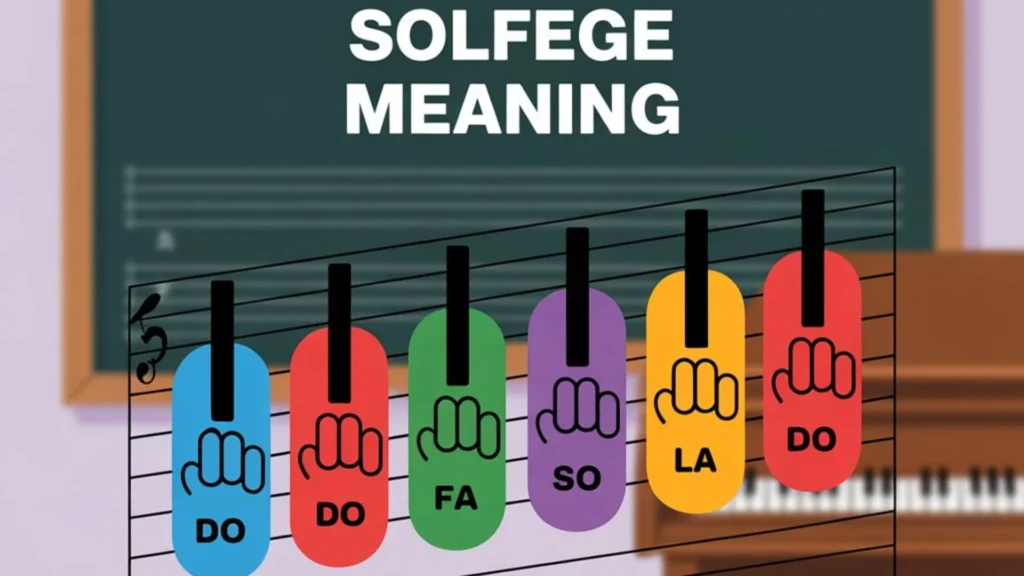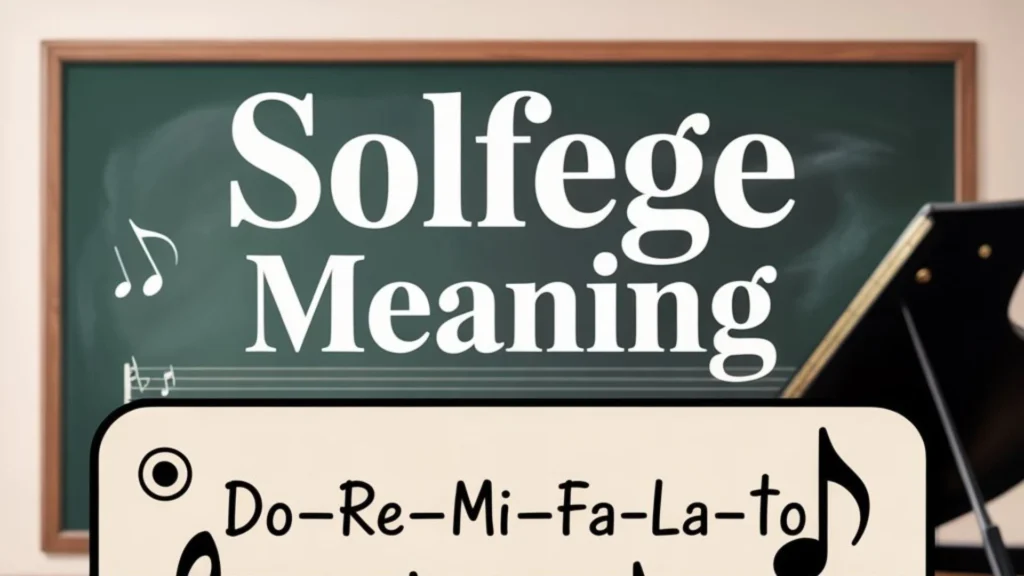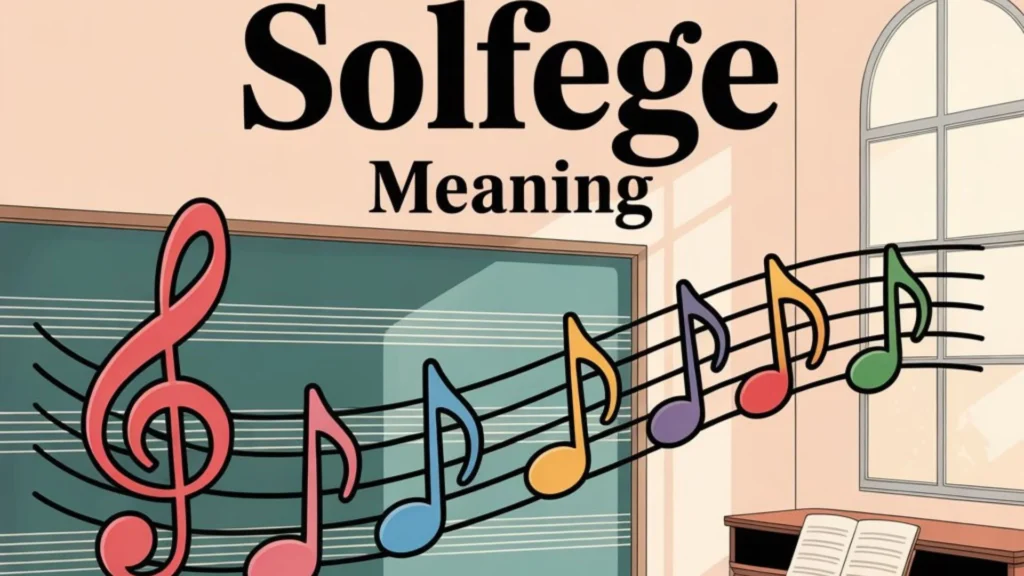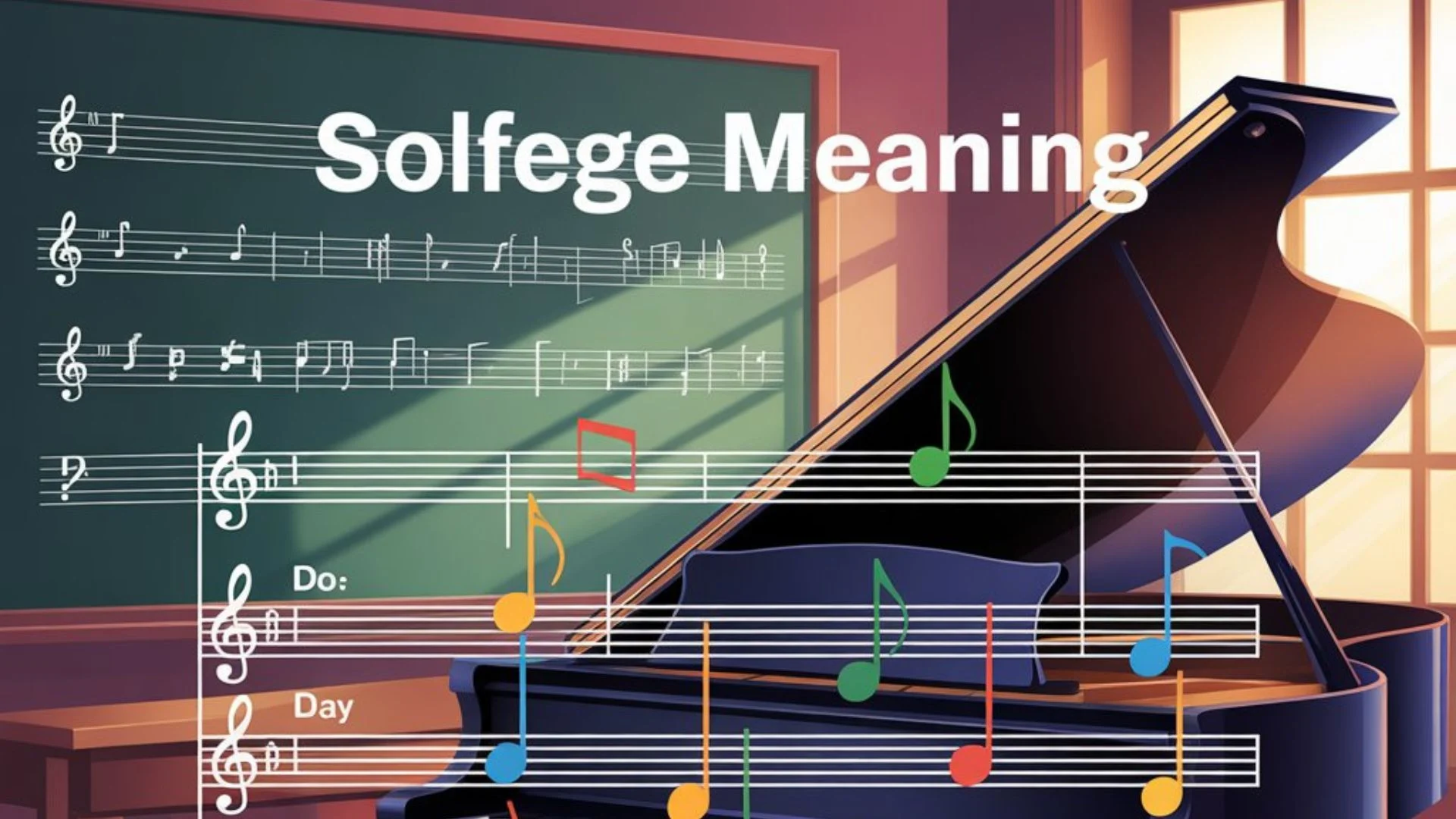When most people think of Solfege Meaning, they instantly hear the familiar “Do-Re-Mi-Fa-Sol-La-Ti-Do.”
Popularized by The Sound of Music, solfege is far more than just a catchy tune.
It’s a powerful music education system that trains the ear, sharpens pitch accuracy, and builds confidence in sight-singing.
But what exactly does solfege mean in music theory, and why has it remained essential for centuries? Let’s dive deep into its definition, history, systems, applications, and cultural impact.
What is Solfege?
At its core, solfege (French: solfège, Italian: solfeggio) is a method of assigning syllables to musical notes.
Instead of singing with “la” or humming, musicians use a structured set of syllables to connect pitch, scale, and interval recognition.
Solfege Definition
- Solfege meaning: A system for teaching pitch and sight-singing using syllables.
- Primary syllables: Do, Re, Mi, Fa, Sol, La, Ti, Do.
- Used by: choirs, pianists, instrumentalists, and music students worldwide.
Functions in Music Theory
- Links scales and intervals to easy-to-remember sounds.
- Helps with ear training and developing relative pitch.
- Serves as a bridge between theory and practice, making abstract notes more accessible.
Misconceptions About Solfege
Despite its musical roots, some confuse solfege with unrelated concepts:
- Solfege = justice (false, mix-up with “solfege” in law or metaphors).
- Solfege = astrology (myth, some link it with Libra or angel numbers).
- Solfege = bowling or internet slang (memes and wordplay only).
👉 In reality, solfege has always been a musical tool, not a spiritual or slang-based one.
History and Origin of Solfege

Understanding where solfege came from reveals why it’s still widely used in music education today.
Guido of Arezzo and Early Development
- In the 11th century, Guido of Arezzo, a Benedictine monk, created a system called solmization.
- He used the hymn Ut queant laxis where each line began on a higher note:
- Ut → Re → Mi → Fa → Sol → La
- Ut → Re → Mi → Fa → Sol → La
- This became the foundation for the modern solfege syllables.
Evolution into Do-Re-Mi
- Later, “Ut” was replaced with “Do” (easier to sing).
- The seventh syllable “Si” (later “Ti”) was added.
- By the Renaissance, solfege had evolved into the seven-note diatonic system we know today.
Spread Through Education
- Adopted by European conservatories for training choirs and musicians.
- Integrated into Latin American and English-speaking music schools.
- Still central in modern Kodály method and other pedagogical systems.
Solfege in Pop Culture
Perhaps the most famous introduction of solfege to the public came in 1959:
- The Sound of Music song “Do-Re-Mi” taught millions about solfege.
- Julie Andrews turned a music theory exercise into a timeless classic.
Types of Solfege Systems

There are two main approaches to solfege: Fixed Do and Movable Do.
Fixed Do Solfege
- Definition: Each syllable always corresponds to the same pitch.
- Do = C, Re = D, Mi = E, etc.
- Do = C, Re = D, Mi = E, etc.
- Common in: France, Spain, Italy, Latin America, and conservatories worldwide.
- Strength: Builds absolute pitch memory.
- Best for: pianists, instrumentalists, and classical training.
Movable Do Solfege
- Definition: Do is always the tonic (first note) of the key.
- In C major → Do = C. In G major → Do = G.
- In C major → Do = C. In G major → Do = G.
- Common in: English-speaking countries and school music education.
- Strength: Trains relative pitch and works across all keys.
- Best for: choirs, beginner singers, and sight-reading practice.
Key Differences
| Feature | Fixed Do | Movable Do |
| Assignment of Do | Always = C | Always = tonic of scale |
| Focus | Absolute pitch | Relative pitch |
| Used in | Conservatories, Europe | Schools, choirs |
| Best suited for | Instrumentalists, pianists | Singers, beginners |
👉 Both systems are valid; many musicians learn both to strengthen their overall ear training.
Functions and Benefits of Solfege in Music Education
Why do music teachers and conservatories insist on using solfege? Because it works.
Ear Training and Pitch Accuracy
- Teaches musicians to hear intervals and recognize notes by ear.
- Strengthens intonation in choirs where pitch can drift.
- Builds the foundation for relative pitch development.
Sight-Singing and Sight-Reading
- Helps singers decode written notes instantly.
- Reduces dependency on instruments during rehearsals.
- Essential for auditions, choir work, and orchestral training.
Memory of Scales and Intervals
- By associating syllables with notes, scales become easier to memorize.
- Reinforces major, minor, chromatic, and modal scales.
Transposing Songs
- Solfege makes it easier to shift songs into different keys.
- Movable Do especially helps singers adjust to new vocal ranges.
Confidence in Performance
- Students trained in solfege perform with greater accuracy.
- Choirs benefit from harmonic balance and reduced tuning errors.
Practical Solfege Applications and Exercises

Using Solfege in Choir Rehearsals
- Choir directors use solfege to teach harmonies efficiently.
- Students learn to adjust pitch blending with their sections.
Hand Signs in Solfege
- The Kodály Method introduced hand signs for each syllable.
- Example: “Do” is a fist, “Re” a slanted hand, “Mi” flat hand, etc.
- This engages visual, auditory, and kinesthetic learning.
Beginner Solfege Drills
- Singing the major scale with syllables.
- Practicing intervals: “Do–Mi–Sol–Do.”
- Echo exercises where the teacher sings a pattern and students repeat.
Advanced Solfege Training
- Chromatic solfege (Do, Di, Re, Ri, etc.).
- Modulation practice (changing keys mid-exercise).
- Complex interval recognition and harmonic dictation.
Integration in Instrumental Training
- Pianists use solfege to associate finger positions with sounds.
- String players use it for intonation and scale memorization.
- Brass and wind players benefit from interval practice.
Solfege in Popular Culture and Modern References

Solfege isn’t confined to classrooms. It appears in surprising cultural and modern contexts.
Solfege in Crossword Puzzles
- Common clue in NYT Crossword: “Note in solfege” (answer: Do, Re, Mi, etc.).
- Popular with puzzle lovers for its short, vowel-rich answers.
Do-Re-Mi in Pop Culture
- Immortalized in The Sound of Music.
- Referenced in countless TV shows, films, and children’s songs.
- Used as a metaphor for learning basics.
Solfege and Memes
- Social media memes twist solfege syllables for humor.
- Example: “Mi, Myself, and Sol.”
- “Skibidi” meme culture occasionally merges with solfege syllables.
Misuses and Myths in Pop Culture
- Some mistakenly link solfege with zodiac signs and astrology.
- Others tie it to angel numbers (333, 555) in New Age circles.
- In reality, solfege has no mystical or astrological connection.
Common Questions About Solfege
What is the difference between solfege and a musical scale?
A scale is a series of pitches; solfege is a system of syllables to label and sing them.
Is solfege outdated in modern music training?
No. Conservatories, schools, and choirs still rely on solfege for ear training, sight-singing, and performance preparation.
Do instrumentalists use solfege?
Yes. Pianists, violinists, and wind players use solfege for scale memorization, interval training, and ear development.
Can solfege help with absolute pitch?
- Fixed Do strengthens absolute pitch recall.
- Movable Do develops relative pitch recognition.
Why is solfege important for beginners?
Because it:
- Makes learning scales intuitive.
- Builds confidence in singing.
- Helps connect music theory with real sound.
Final Thoughts on Solfege Meaning
The meaning of solfege goes far beyond a simple “Do-Re-Mi.” It’s a time-tested music education system that enhances pitch, improves memory, and builds confidence for both beginners and professionals.
From Guido of Arezzo’s medieval innovations to Julie Andrews in The Sound of Music, solfege has shaped how musicians learn and perform across centuries.
Whether you’re a choir student, pianist, or crossword enthusiast, solfege continues to bridge theory and practice in the most accessible way possible.


